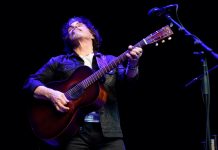
When pianist Herbie Hancock gazed out over Piedmont Park on Memorial Day in 2007, there was barely a patch of grass unoccupied by picnic blankets or folding chairs. It was closing night of the three-day Atlanta Jazz Festival, and 100,000 people packed the park to celebrate the free event’s thirtieth anniversary. A year later, a relatively meager crowd wedged into Downtown’s Woodruff Park for just two days of concerts. The event had to be relocated due to drought, costing the festival thousands in lost sponsorship dollars. Organizers staged a “no-frills festival,” relying mostly on $120,000 in residual funds, says Camille Russell Love, director of the Office of Cultural Affairs. “I basically told my staff, we’re going to create a festival that we can afford to create,” she says. “We’ll use local artists, but we won’t lose the momentum of the festival.”
 Photograph of 29th Street Saxophone Quartet, 1988, by Susan Ross; view a gallery of more performers from throughout the festival’s history |
As the event marks its thirty-fifth anniversary this month, momentum is rolling again. Private donations and grants are up, and city funding is back after drying up completely in the early 2000s. Organizers are predicting daily attendance of up to 75,000 (versus 50,000 in 2011) and revenue of $500,000 (versus $315,000 in 2011). Cyrus Chestnut, an internationally known pianist who will make his third appearance this year, ranks Atlanta’s celebration near the top. “The Atlanta Jazz Festival has always been one of the signature festivals in the United States,” he says. “It is a major stop.”
Ebbs and flows have characterized the festival’s entire history. In June 1978, jazz lover Mayor Maynard Jackson inaugurated the event. With a plush budget and full support from city government, the festival could pay upwards of $30,000 to bring in legendary artists like Miles Davis and Sarah Vaughan. But city funding plummeted during the early 1990s, when director John Armwood had to bank on personal connections to lure national artists like Abbey Lincoln, Jackie McLean, and the Harper Brothers, often for just a few thousand dollars. By the late 1990s, with funding from the city’s hotel-motel tax, the event was flush again. The Office of Cultural Affairs received more than $1 million annually to stage the Jazz Festival and Atlanta’s now-defunct Montreux Jazz Festival.
>> MAY 26–28: The thirty-fifth festival returns to Piedmont Park, with two stages featuring international and local artists as well as youth jazz bands. Most events are free. Headliners include Chestnut, along with Roy Ayers, Tito Puente Jr., and Robert Glasper. Every day this month, local artists also perform in area venues as part of the 31 Days of Jazz program. |
It is ironic that a city not known for jazz has such a well-known festival. But Armwood, a longtime announcer for Jazz 91.1 WCLK, notes that though the local jazz scene has been small, it’s been consistent. The vibe dates back to the 1960s, when Paschal’s La Carousel Lounge hosted legends like Quincy Jones and Jimmy Smith. Local clubs such as Churchill Grounds and Cafe 290 have drawn loyal audiences for decades.
Atlanta-based trumpeter Melvin Jones credits the festival with generating community awareness that benefits local artists. “The festival,” he says, “is a way to pronounce to the world that the musical culture of this city has a very strong live component outside of pop, R&B, gospel, and hip-hop.”
Russell Love agrees: “The jazz festival is our way of making sure we give [the audience] not just the hip-hop that pervades Atlanta.” For at least one month a year, Atlanta becomes a jazz town.
















